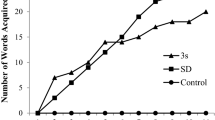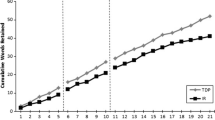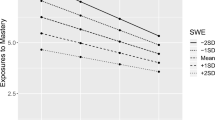Abstract
This paper reviews the evidence on sight word instruction as a method of teaching students with autism and significant cognitive and verbal limitations to read printed words. Nine single-subject studies were rated using Reichow et al.’s (J Autism Dev Disord 38:1311–1319, 2008) evaluative method for identifying evidence-based practice, and studies with at least adequate methodology were analyzed to identify common intervention features. Results yielded evidence in support of a massed trials approach featuring student response to a succession of items, differential positive reinforcement, systematic prompting, and use of visual supports. Across studies, students learned to identify printed words, even those with limited oral language and no prior reading instruction. However, no studies addressed the effects of sight word instruction on broad literacy outcomes.
Similar content being viewed by others
References
Birkan, B., McClannahan, L., & Krantz, P. (2007). Effects of superimposition and background fading on the sight-word reading of a boy with autism. Research in Autism Spectrum Disorders, 1, 117–125.
Broun, L. T. (2004). Teaching students with autism spectrum disorders to read: A visual approach. Teaching Exceptional Children, 36, 36–40.
Broun, L. T., & Oelwein, P. (2007). Literacy development for students with special learning needs: A strength-based approach. Port Chester, NY: National Professional resources, Inc.
Browder, D. M. (2001). Curriculum and assessment for students with moderate and significant disabilities. NY: Guilford Press.
Browder, D., & Xin, Y. (1998). A meta-analysis and review of sight word research and its implications for teaching functional reading to individuals with moderate and severe disabilities. Journal of Special Education, 32, 130–153.
Browder, D. M., Courtade-Little, G., Wakeman, S., & Rickelman, R. J. (2006a). From sight words to emergent literacy. In D. Browder & F. Spooner (Eds.), Teaching language arts, math and science to students with significant cognitive disabilities (pp. 63–91). Baltimore: Paul H. Brookes Publishing.
Browder, D. M., Wakeman, S., Spooner, F., Ahlgrim-Delzell, L., & Algozzine, B. (2006b). Research on reading instruction for individuals with significant cognitive disabilities. Exceptional Children, 72, 392–408.
Browder, D. M., Ahlgrim-Delzell, L., Spooner, F., Mims, P., & Baker, J. N. (2009). Using time delay to teach literacy to students with severe developmental disabilities. Exceptional Children, 75, 343–364.
Chard, D. J., Ketterlin-Geller, L. R., Baker, S., Doabler, C., & Apichatabutra, C. (2009). Repeated reading interventions for students with learning disabilities: Status of the evidence. Exceptional Children, 75, 263–281.
Chiang, H., & Lin, Y. (2007). Reading comprehension instruction for students with autism spectrum disorders: A review of the literature. Focus on Autism and Other Developmental Disabilities, 22, 259–267.
Collins, B. C., & Stinson, D. M. (1994). Teaching generalized reading of product warning labels to adolescents with mental disabilities through the use of key words. Exceptionality, 5, 163–181.
Cook, B. G., Tankersley, M., & Landrum, T. J. (2009). Determining evidence-based practices in special education. Exceptional Children, 75, 365–383.
Copeland, S. R., & Calhoon, J. A. (2007). Word recognition instruction. In S. R. Copeland & E. B. Keefe (Eds.), Effective literacy instruction for students with moderate or severe disabilities (pp. 41–62). Baltimore: Paul Brookes Publishing.
Ehri, L. C. (2005). Learning to read words: Theory, findings, and issues. Scientific Studies of Reading, 9, 167–188.
Eikeseth, S., & Jahr, E. (2001). The UCLA reading and writing program: An evaluation of the beginning stages. Research in Developmental Disabilities, 22, 289–307.
Fossett, B., & Mirenda, P. (2006). Sight word reading in children with developmental disabilities: A comparison of paired associate and picture-to-text matching instruction. Research in Developmental Disabilities, 27, 411–429.
Gough, P. B., Juel, C., & Roper-Schneider, D. (1983). A two-stage model of initial reading acquisition. In J. A. Niles & L. A. Harris (Eds.), Searches for meaning in reading/language processing and instruction (pp. 207–211). Rochester NY: National Reading Conference.
Gough, P. B., Hoover, W. A., & Peterson, C. L. (1996). Some observations on a simple view of reading. In C. Cornoldi & J. Oakhill (Eds.), Reading comprehension difficulties (pp. 1–13). Mahwah, NJ: Erlbaum.
Hetzroni, O., & Shalem, U. (2005). From logos to orthographic symbols: A multilevel fading computer program for teaching nonverbal children with autism. Focus on Autism and Other Developmental Disabilities, 20, 201–212.
Horner, R., Carr, E., Halle, J., McGee, G., Odom, S., & Wolery, M. (2005). The use of single-subject research to identify evidence-based practice in special education. Exceptional Children, 71, 165–179.
Huemer, S. V., & Mann, V. (2010). A comprehensive profile of decoding and comprehension in autism spectrum disorders. Journal of Autism and Developmental Disorders, 40, 485–493.
Kaderavek, J. N., & Rabidoux, P. (2004). Interactive to independent literacy: A model for designing literacy goals for children with atypical communication. Reading and Writing Quarterly, 20, 237–260.
Kamps, D., Walker, D., Locke, P., Delquadri, J. and Hall, R. V. (1990). Education and Treatment of Children, 13, 197–215.
Kazdin, A. E. (1982). Single-case research designs: Methods for clinical and applied settings. NY: Oxford University Press.
Kliewer, C., & Biklen, D. (2001). “School’s not really a place for reading”: A research synthesis of the literate lives of students with severe disabilities. The Journal for the Association for Persons with Severe Handicaps, 26, 1–12.
Kluth, P., & Chandler-Olcott, K. (2008). “A land we can share”: Teaching literacy to students with autism. Baltimore: Paul H. Brookes Publishing.
Koppenhaver, D., & Erickson, K. (2009). Literacy in individuals with autism spectrum disorders who use AAC. In P. Mirenda & T. Iacono (Eds.), Autism spectrum disorders and AAC (pp. 385–412). Baltimore: Paul H. Brookes Publishing.
Lanter, E., & Watson, L. R. (2008). Promoting literacy in students with ASD: The basics for the SLP. Language, Speech, and Hearing Services, 39, 33–43.
Ledford, J. R., Gast, D. L., Luscre, D., & Ayres, K. M. (2008). Observational and incidental learning by children with autism during small group instruction. Journal of Autism and Developmental Disorders, 38, 86–103.
Lord, C., Wagner, A., Rogers, S., Szatmari, P., Aman, M., Charman, T., et al. (2005). Challenges in evaluating psychosocial interventions for autistic spectrum disorders. Journal of Autism and Developmental Disorders, 35, 695–708.
McGee, G., Krantz, P., & McClannahan, L. (1986). An extension of incidental teaching procedures to reading instruction for autistic children. Journal of Applied Behavior Analysis, 19, 147–157.
Mechling, L. C., Gast, D. L., & Langone, J. (2002). Computer-based video instruction to teach persons with moderate intellectual disabilities to read grocery aisle signs and locate items. Journal of Special Education, 35, 224–240.
Mirenda, P. (2003). “He’s not really a reader”…: Perspectives on supporting literacy development in individuals with autism. Topics in Language Disorders, 23, 271–282.
Nation, K., Clarke, P., Wright, B., & Williams, C. (2006). Patterns of reading ability in children with autism spectrum disorder. Journal of Autism and Developmental Disorders, 36, 911–919.
Odom, S. L., Brown, W. H., Frey, T., Karasu, N., Smith-Canter, L., & Strain, P. (2003). Evidence-based practices for young children with autism: Contributions for single-subject design research. Focus on Autism and Other Developmental Disorders, 18, 166–175.
Odom, S. L., Brantlinger, E., Gersten, R., Horner, R., Thompson, B., & Harris, K. (2005). Research in special education: Scientific methods and evidence-based practices. Exceptional Children, 71, 137–148.
Odom, S. L., Rogers, S., McDougle, C. J., Hume, K., & McGee, G. (2007). Early intervention for children with autism spectrum disorder. In S. L. Odom, R. H. Horner, M. E. Snell, & J. Blacher (Eds.), Handbook of developmental disabilities (pp. 199–223). NY: Guilford Press.
Reichow, B., Volkmar, F. R., & Cicchetti, D. V. (2008). Development of the evaluative method for evaluating and determining evidence-based practices in autism. Journal of Autism and Developmental Disorders, 38, 1311–1319.
Rosenberg, M. S., Bott, D., Majsterek, D., Chiang, B., Gartland, D., Wesson, C., et al. (1992). Minimum standards for the description of participants in learning disabilities research. Learning Disability Quarterly, 15, 65–70.
Schopler, E., Reichler, R. J., & Renner, B. R. (1998). Childhood autism rating scale. Los Angeles, CA: Western Psychological Services.
Simpson, R. L., & Myles, B. S. (2008). Educating children and youth with autism: Strategies for effective practice (2nd ed.). Austin, TX: Pro-ed.
Snow, C. E., Burns, M. S., & Griffin, P. (Eds.). (1998). Preventing reading difficulties in young children. Washington, DC: National Academy Press.
SRI International. (2002). SEELS data tables. Retrieved from http://www.seels.net/search/datatableOverview.htm.
Whalon, K. J., Al Otaiba, S., & Delano, M. (2009). Evidence-based reading instruction for individuals with autism spectrum disorders. Focus on Autism and Other Developmental Disorders, 24, 3–16.
Woodcock, R. W., McGrew, K. S., & Mather, N. (2001). Woodcock Johnson III tests of achievement. Itasca, IL: Riverside Publishing.
Acknowledgments
Sarah Rockwell, University of Florida, served as the second rater in coding and evaluating all studies. Brian Reichow, Yale University, provided assistance with initial rating questions.
Author information
Authors and Affiliations
Corresponding author
Rights and permissions
About this article
Cite this article
Spector, J.E. Sight Word Instruction for Students with Autism: An Evaluation of the Evidence Base. J Autism Dev Disord 41, 1411–1422 (2011). https://doi.org/10.1007/s10803-010-1165-x
Published:
Issue Date:
DOI: https://doi.org/10.1007/s10803-010-1165-x




